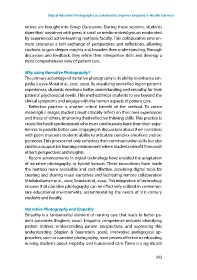Page 343 - International Perspectives on Effective Teaching and Learning in Digital Education
P. 343
Digital Narrative Photography as a Method to Improve Empathy in Health Sciences
ratives are brought into Group Discussions. During these sessions, students
share their narratives with peers in small or medium-sized groups moderated
by experienced active-learning methods faculty. This collaborative environ-
ment promotes a rich exchange of perspectives and reflections, allowing
students to gain deeper insights and broaden their understanding. Through
discussion and feedback, they refine their interpretive skills and develop a
more comprehensive view of patient care.
Why using Narrative Photography?
The primary advantage of narrative photography is its ability to enhance em-
pathy (Leyva-Moral et al., 1, ). By visualizing and reflecting on patients’
experiences, students develop a better understanding and empathy for their
patients’ psychosocial needs. This method helps students to see beyond the
clinical symptoms and engage with the human aspects of patient care.
Reflective practice is another critical benefit of the method. To create
meaningful images students must critically reflect on their own experiences
and those of others, improving their reflective thinking skills. This practice is
crucial for health professionals who must continuously learn from their expe-
riences to provide better care. Engaging in discussions about their narratives
with peers sharpens students’ ability to articulate complex emotions and ex-
periences. This process not only enhances their communication skills but also
creates a supportive learning environment where students benefit from each
other’s perspectives and insights.
Recent advancements in digital technology have enabled the adaptation
of narrative photography to hybrid formats. These innovations have made
the method more accessible and cost-effective, providing digital tools for
creating and sharing visual narratives and facilitating remote collaboration
(Abdulrahaman et al., ; Smeda et al., 14). This integration of technology
ensures that narrative photography can be effectively utilized in contempo-
rary educational environments, accommodating the needs of 1st-century
students and faculty.
Narrative Photography and Empathy
Empathy is a fundamental element of nursing care that leads to better pa-
tient outcomes (Engbers, ). Empathic competence includes identifying
patient distress, understanding patient perspectives, and expressing this
understanding (Stepien & Baernstein, 6). Innovative pedagogical ap-
proaches, such as narrative photography, have proven effective in educating
nursing students about empathy and humanised care. There is a significant
343

